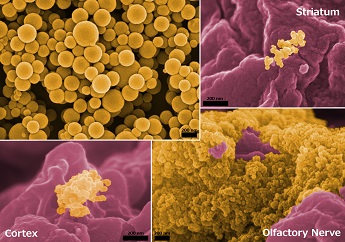
Caption:
False color image of gelatin nanoparticles (gold) in various regions of a rat brain following intranasal administration. Upper left panel shows gelatin nanoparticles before intranasal administration. Scale bar = 200 nm.
Elizabeth Sawickia,b,, Kevin Kima,c, Hyungsoo Choid
Advisor: Prof. Kevin Kim and Prof. Hyungsoo Choi
aDepartment of Bioengineering
University of Illinois at Urbana-Champaign
bMedical Scholars Program
University of Illinois at Urbana-Champaign
cDepartment of Material Science and Engineering, Neuroscience Program, and Institute for Genomic Biology
University of Illinois at Urbana-Champaign
dMicro and Nanotechnology Laboratory and Department of Electrical and Computer Engineering University of Illinois at Urbana-Champaign
Technique: Scanning electron microscopy using Hitachi S-4800 Field Emission SEM with Au-Pd sputter coated samples.
Description:
Though ischemic stroke is a leading cause of death and adult disability, there are few effective treatments currently available. One solution is to use nanotechnology to deliver drugs intranasally, a method that is simple and convenient for patients. We are developing gelatin nanoparticles (GNPs) to safely transport drug molecules from the nasal cavity into the brains of stroke patients without the need for an injection. This image shows that GNPs can be delivered to many different brain regions using the nasal route. Later, we loaded these GNPs with drugs, administered them intranasally to rats, and were able to significantly reduce brain damage while promoting healing after a stroke. Though we are currently studying intranasal GNPs in mice and rats with strokes, a fundamental understanding of the way gelatin nanoparticles interact with the brain will allow this technology to someday be applied to human illness.
Funding Source: National Cancer Institute Siteman Center for Cancer Nanotechnology Excellence


